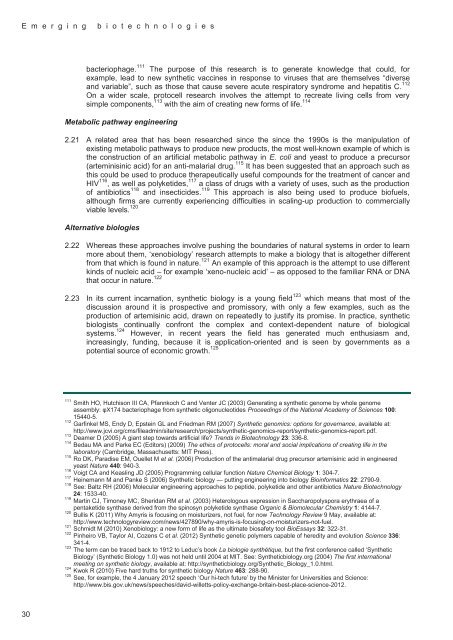Emerging biotechnologies: full report - Nuffield Council on Bioethics
Emerging biotechnologies: full report - Nuffield Council on Bioethics
Emerging biotechnologies: full report - Nuffield Council on Bioethics
Create successful ePaper yourself
Turn your PDF publications into a flip-book with our unique Google optimized e-Paper software.
E m e r g i n g b i o t e c h n o l o g i e s<br />
bacteriophage. 111 The purpose of this research is to generate knowledge that could, for<br />
example, lead to new synthetic vaccines in resp<strong>on</strong>se to viruses that are themselves “diverse<br />
and variable”, such as those that cause severe acute respiratory syndrome and hepatitis C. 112<br />
On a wider scale, protocell research involves the attempt to recreate living cells from very<br />
simple comp<strong>on</strong>ents, 113 with the aim of creating new forms of life. 114<br />
Metabolic pathway engineering<br />
2.21 A related area that has been researched since the since the 1990s is the manipulati<strong>on</strong> of<br />
existing metabolic pathways to produce new products, the most well-known example of which is<br />
the c<strong>on</strong>structi<strong>on</strong> of an artificial metabolic pathway in E. coli and yeast to produce a precursor<br />
(arteminisinic acid) for an anti-malarial drug. 115 It has been suggested that an approach such as<br />
this could be used to produce therapeutically useful compounds for the treatment of cancer and<br />
HIV 116 , as well as polyketides, 117 a class of drugs with a variety of uses, such as the producti<strong>on</strong><br />
of antibiotics 118 and insecticides. 119 This approach is also being used to produce biofuels,<br />
although firms are currently experiencing difficulties in scaling-up producti<strong>on</strong> to commercially<br />
viable levels. 120<br />
Alternative biologies<br />
2.22 Whereas these approaches involve pushing the boundaries of natural systems in order to learn<br />
more about them, ‘xenobiology’ research attempts to make a biology that is altogether different<br />
from that which is found in nature. 121 An example of this approach is the attempt to use different<br />
kinds of nucleic acid – for example ‘xeno-nucleic acid’ – as opposed to the familiar RNA or DNA<br />
that occur in nature. 122<br />
2.23 In its current incarnati<strong>on</strong>, synthetic biology is a young field 123 which means that most of the<br />
discussi<strong>on</strong> around it is prospective and promissory, with <strong>on</strong>ly a few examples, such as the<br />
producti<strong>on</strong> of artemisinic acid, drawn <strong>on</strong> repeatedly to justify its promise. In practice, synthetic<br />
biologists c<strong>on</strong>tinually c<strong>on</strong>fr<strong>on</strong>t the complex and c<strong>on</strong>text-dependent nature of biological<br />
systems. 124 However, in recent years the field has generated much enthusiasm and,<br />
increasingly, funding, because it is applicati<strong>on</strong>-oriented and is seen by governments as a<br />
potential source of ec<strong>on</strong>omic growth. 125<br />
111 Smith HO, Hutchis<strong>on</strong> III CA, Pfannkoch C and Venter JC (2003) Generating a synthetic genome by whole genome<br />
assembly: φX174 bacteriophage from synthetic olig<strong>on</strong>ucleotides Proceedings of the Nati<strong>on</strong>al Academy of Sciences 100:<br />
15440-5.<br />
112 Garfinkel MS, Endy D, Epstein GL and Friedman RM (2007) Synthetic genomics: opti<strong>on</strong>s for governance, available at:<br />
http://www.jcvi.org/cms/fileadmin/site/research/projects/synthetic-genomics-<str<strong>on</strong>g>report</str<strong>on</strong>g>/synthetic-genomics-<str<strong>on</strong>g>report</str<strong>on</strong>g>.pdf.<br />
113 Deamer D (2005) A giant step towards artificial life? Trends in Biotechnology 23: 336-8.<br />
114 Bedau MA and Parke EC (Editors) (2009) The ethics of protocells: moral and social implicati<strong>on</strong>s of creating life in the<br />
laboratory (Cambridge, Massachusetts: MIT Press).<br />
115 Ro DK, Paradise EM, Ouellet M et al. (2006) Producti<strong>on</strong> of the antimalarial drug precursor artemisinic acid in engineered<br />
yeast Nature 440: 940-3.<br />
116 Voigt CA and Keasling JD (2005) Programming cellular functi<strong>on</strong> Nature Chemical Biology 1: 304-7.<br />
117 Heinemann M and Panke S (2006) Synthetic biology — putting engineering into biology Bioinformatics 22: 2790-9.<br />
118 See: Baltz RH (2006) Molecular engineering approaches to peptide, polyketide and other antibiotics Nature Biotechnology<br />
24: 1533-40.<br />
119 Martin CJ, Tim<strong>on</strong>ey MC, Sheridan RM et al. (2003) Heterologous expressi<strong>on</strong> in Saccharopolyspora erythraea of a<br />
pentaketide synthase derived from the spinosyn polyketide synthase Organic & Biomolecular Chemistry 1: 4144-7.<br />
120 Bullis K (2011) Why Amyris is focusing <strong>on</strong> moisturizers, not fuel, for now Technology Review 9 May, available at:<br />
http://www.technologyreview.com/news/427890/why-amyris-is-focusing-<strong>on</strong>-moisturizers-not-fuel.<br />
121 Schmidt M (2010) Xenobiology: a new form of life as the ultimate biosafety tool BioEssays 32: 322-31.<br />
122 Pinheiro VB, Taylor AI, Cozens C et al. (2012) Synthetic genetic polymers capable of heredity and evoluti<strong>on</strong> Science 336:<br />
341-4.<br />
123 The term can be traced back to 1912 to Leduc’s book La biologie synthétique, but the first c<strong>on</strong>ference called ‘Synthetic<br />
Biology’ (Synthetic Biology 1.0) was not held until 2004 at MIT. See: Syntheticbiology.org (2004) The first internati<strong>on</strong>al<br />
meeting <strong>on</strong> synthetic biology, available at: http://syntheticbiology.org/Synthetic_Biology_1.0.html.<br />
124 Kwok R (2010) Five hard truths for synthetic biology Nature 463: 288-90.<br />
125 See, for example, the 4 January 2012 speech ‘Our hi-tech future’ by the Minister for Universities and Science:<br />
http://www.bis.gov.uk/news/speeches/david-willetts-policy-exchange-britain-best-place-science-2012.<br />
30
















